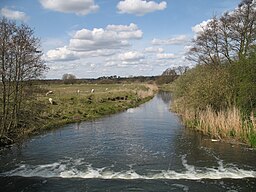River Lark
| River Lark | |
|
The river near Icklingham
|
|
| Primary source | Whepstead |
|---|---|
| - elevation | 104 m (341 ft) |
| - coordinates | 52°11′18″N 0°39′09″E / 52.1883°N 0.6525°E |
| Secondary source | Bradfield Combust |
| - elevation | 65 m (213 ft) |
| - coordinates | 52°10′39″N 0°43′57″E / 52.1775°N 0.7325°E |
| Mouth | Littleport, River Great Ouse |
| - elevation | 0 m (0 ft) |
| - coordinates | 52°26′07″N 0°18′43″E / 52.4352°N 0.3120°ECoordinates: 52°26′07″N 0°18′43″E / 52.4352°N 0.3120°E |
| Length | 31 km (19 mi) |
The River Lark is a river in England that crosses the border between Suffolk and Cambridgeshire. It is a tributary of the River Great Ouse, and was extended when that river was re-routed as part of drainage improvements. It is thought to have been used for navigation since Roman times, and improvements were made in 1638 and in the early 18th century, when locks and staunches were built. The upper terminus was on the northern edge of Bury St Edmunds, but a new dock was opened near the railway station after the Eastern Union Railway opened its line in 1846.
The navigation was officially abandoned in 1888, but despite this, commercial use of the river continued until 1928. Following acquisition by the Great Ouse Catchment Board, locks at Barton Mills and Icklingham were rebuilt in the 1960s, but were isolated when the A11 road bridge was lowered soon afterwards. It now has one operational lock at Isleham, and can be navigated to Jude's Ferry.
Rising at Bradfield Combust, to the south of Bury St Edmunds in Suffolk, it flows through Bury, Mildenhall and Prickwillow, and joins the Great Ouse south of Littleport in Cambridgeshire. It is about 31 miles (50 km) long, of which 10.1 miles (16.3 km) is navigable.
The upper river is an important focus for prehistoric activity, particularly relating to the Neolithic enclosure at Fornham All Saints.Culford School is situated on the north bank at West Stow, and the river plays an important part in school life, being used for activities such as punting and rowing.
Just above Barton Mills, a side weir connects the river to the start of the Cut-off Channel, a 25-mile (40 km) drain running from there to Denver along the south-eastern edge of the Fens, which was constructed in the 1950s and 1960s. During times of flood it carries the head waters of the River Lark, the River Wissey and the Little Ouse to Denver Sluice on the River Great Ouse.
...
Wikipedia


